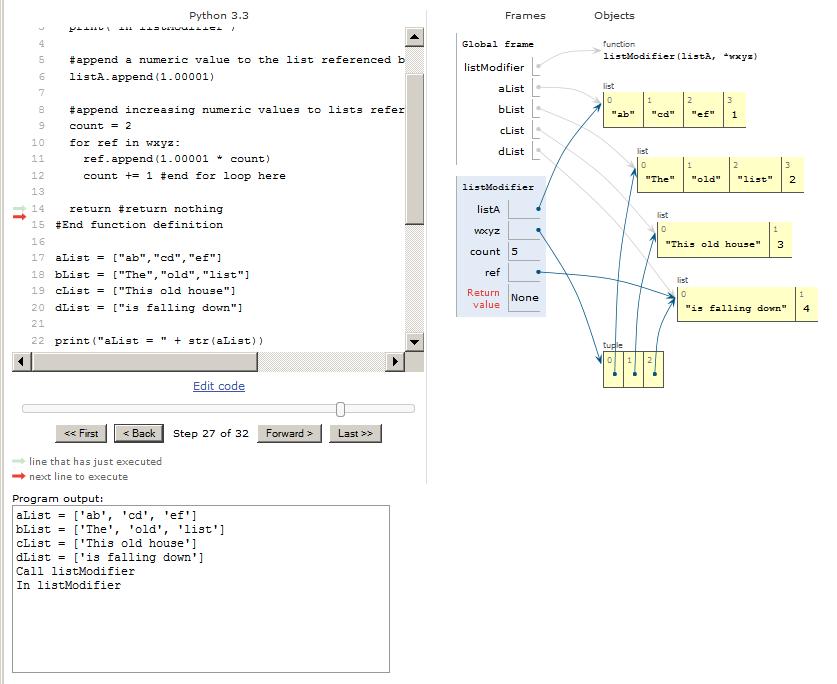| << Chapter < Page | Chapter >> Page > |
In this program, the calling program must pass a parameter for the required argument and can pass an arbitrary number of parameters following the requiredargument.
The second thing you should pay attention to is the syntax used to call the function named listModifier about six lines up from the bottom of Listing 5 . The function call passes four parameters: aList , bList, cList , and dList , each of which is a reference to a list object.
The reference variable named aList is passed as the first parameter to satisfy the required argument named listA . Note that it is passed using the same syntax as in Listing 1 , Listing 2 , Listing 3 and Listing 4 . Because it is a required argument, it must be passed in the correct order in apositional sense.
The remaining three parameters are passed as variable-length arguments. The interpreter wraps them in a tuple and presents the tuple to the code in the bodyof the function. (You learned about tuples in the earlier module titled Itse1359-1100-Indexing and Slicing Tuples and several modules following that one.)
The code in the body of the function uses the parameter passed as the required argument to append a numeric value to the list referred to by thatparameter.
Although a tuple is immutable, the list objects referred to by the elements in the tuple are mutable. A for loop in the functions iterates from the beginning to the end of the tuple, extracting the references to thelists and appending an increasing numeric value to the end of each list. This is shown in the last four lines of text in Figure 6 .
Note that if the order in which the function processes the arguments is important, the order in which the calling program passes the parameters mustmatch that order because that is the order in which they will be wrapped in the tuple.
Hopefully this explanation along with the code in Listing 5 and the output in Figure 6 will tell you what you need to know about using variable-length function arguments. I do want to caution again, however, that this module does notprovide a complete treatment of function arguments. For a more compete treatment, I will refer you to The Python Tutorial -- More on Defining Functions and tutorialspoint -- Python Functions .
Figure 7 shows a visualization of the code in Listing 5 part of the way through the execution of the program. Note that in order to reduce the amount of vertical space required to publish the visualization , one of the visualization parameters was changed to "inline primitives and nested objects [default]."
Figure 7. Visualization of variable-length arguments.

I recommend that you create a visualization for the code in Listing 5 and step through the program one instruction at a time. As you do that, pay attention to the movements of the red and green arrows on the left, thediagram on the right, and the printed material at the bottom. That should help you to better understand the concept of variable-length arguments.
I encourage you to copy the code from Listing 1 , Listing 2 , Listing 3 , Listing 4 , and Listing 5 . Execute the code and confirm that you get the same results as those shown in in this module. Experiment with the code,making changes, and observing the results of your changes. Make certain that you can explain why your changes behave as they do.
I also recommend that you create visualizations for the code in Listing 1 through Listing 5 . Step through the programs one instruction at a time. As you do that, pay attention tothe movements of the red and green arrows on the left, the diagram on the right, and the printed material at the bottom. That should help you to betterunderstand the concepts embodied in those sample programs.
This section contains a variety of miscellaneous information.
Financial : Although the Connexions site makes it possible for you to download a PDF file for thismodule at no charge, and also makes it possible for you to purchase a pre-printed version of the PDF file, you should beaware that some of the HTML elements in this module may not translate well into PDF.
I also want you to know that, I receive no financial compensation from the Connexions website even if you purchase the PDF version of the module.
In the past, unknown individuals have copied my modules from cnx.org, converted them to Kindle books, and placed them for sale on Amazon.com showing me as the author. Ineither receive compensation for those sales nor do I know who does receive compensation. If you purchase such a book, please beaware that it is a copy of a module that is freely available on cnx.org and that it was made and published withoutmy prior knowledge.
Affiliation : I am a professor of Computer Information Technology at Austin Community College in Austin, TX.
-end-

Notification Switch
Would you like to follow the 'Itse 1359 introduction to scripting languages: python' conversation and receive update notifications?